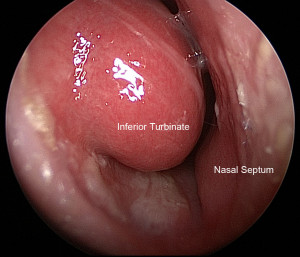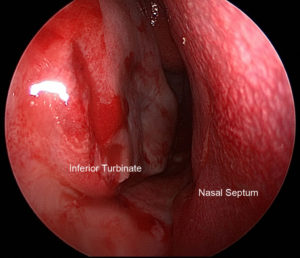Many people struggle with nasal congestion. Different issues can lead to nasal congestion. Some of the more common causes of chronic nasal congestion include allergies, a deviated nasal septum, enlargement of the turbinates, and nasal valve narrowing.
The turbinates are normal structures inside the nose. There are multiple sets of turbinates. The turbinates closest to the bottom of the nose are called the inferior turbinates. They project into the nasal passage from the side of the nose. These inferior turbinates are thought to help warm, humidify, and filter the air we breathe through our noses.
When the turbinates become too large, it may be difficult to breathe through the nose. Oftentimes, patients with enlarged turbinates notice that their nose becomes more congested when they are lying down. They may also find that the congestion switches from side to side while they are trying to sleep. Turbinates can swell and shrink throughout the day and night, causing congestion to switch back and forth.
Many patients with enlarged turbinates get better with medications. Often, nasal sprays can help shrink swollen turbinates. Allergy treatments can also help shrink swollen turbinates.
When medications and allergy treatments do not help improve symptoms in patients with enlarged turbinates, we can sometimes consider surgery as an option to reduce the size of the turbinates.
Surgery is typically called turbinate reduction or turbinate resection. Patients can choose to have the surgery in the office or in the operating room. In many instances, enlarged turbinates are only one part of the problem. Some patients also have problems like a deviated nasal septum. In these cases, patients may have procedures like septoplasty at the same time they have their turbinates reduced.
There are many ways to shrink the size of the turbinates.
Examples of different types of procedures used for enlarged turbinates are cauterization, coblation, radiofrequency reduction, microdebrider resection, and partial resection. All of these terms refer to treatments that can reduce the size of the turbinates.
A very effective way of treating patients with enlarged turbinates is a procedure called “submucosal resection.” This type of surgery involves removing some of the “stuffing” from the inside of the turbinate. This procedure preserves the tissue along the the surface of the turbinate. The surface tissue is what allows the turbinate to provide warmth and humidification for air as we breathe. So, the goal is to shrink the tissue on the interior of the turbinate while preserving the surface tissue.
To perform the procedure, the surgeon makes a small incision at the front of the turbinate. Then, the surgeon removes some of the soft tissue and bone that make up the inside of the turbinate. As the turbinates heal, they will be smaller than they were before the procedure.
Below is one example of how the shape of a turbinate changes as the procedure is performed.


During the recovery period after turbinate reduction, most patients have pain, fatigue, nasal stuffiness, and nasal drainage after surgery. Pain is generally very mild with this type of surgery. Most patients tell us that they have to take only a few doses of their pain medicine during the entire postoperative period.
Most patients find that they are very stuffy right after surgery from the swelling after the procedure. This typically starts to improve about a week after surgery. Patients typically have drainage of some mucus and blood from your nose after surgery. This is a normal part of the healing process. After surgery, we recommend that you use saline sprays and nasal rinses. You can find sprays and rinse kits at most pharmacies. Our patients find the NeilMed Sinus Rinse kit easy to use. You can find out more information about the kit at www.neilmed.com.
